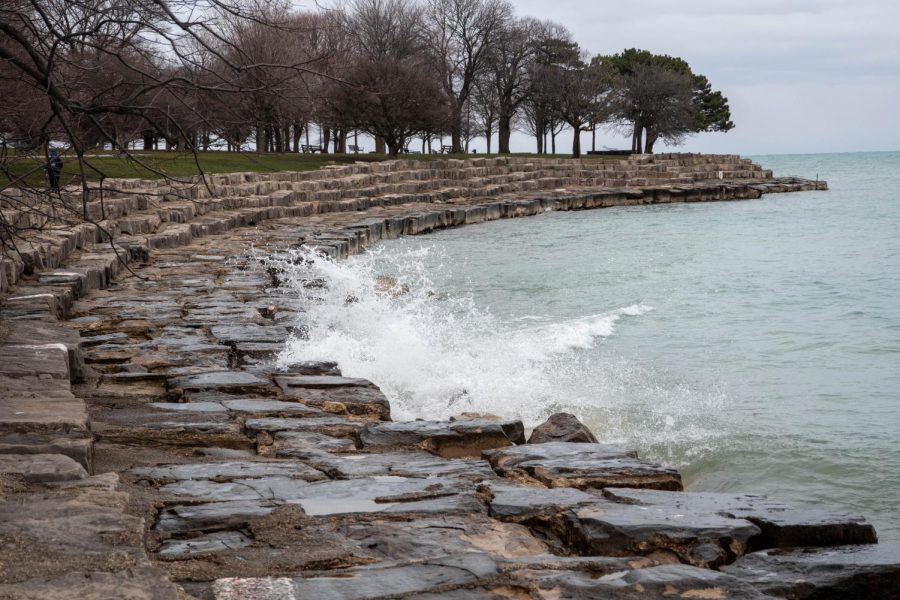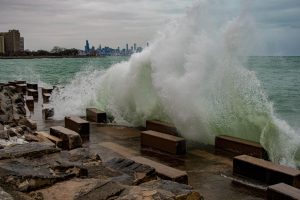Keep the historic significance of ‘the Point’
Waves crash onto the iconic limestone rocks which encircle the Point.
As the Midway sees it…
Almost 20 years after first organizing against the city’s push to replace the limestone steps at Promontory Point with concrete, Hyde Park community members are expressing concerns about the plans and are ready to organize all over again. Replacing the limestone revetments removes the Point’s historical and nostalgic significance, is less aesthetically pleasing and overlooks the durability and accessibility limestone would gain if restored.
Promontory Point is a 40-acre peninsula on Chicago’s lakefront running from 54th to 56th streets and surrounded by large limestone rocks that lead to the lake. “The Point,” as locals refer to it, serves as a serene landscape where people go to jog, build campfires, walk dogs, swim and much more.
The limestone revetments have always faced the danger of erosion and a lack of maintenance. In 1980, the city, Chicago Park District and United States Army Corps of Engineers created a $300 million plan to replace the limestone revetments with concrete. Members of the Promontory Point Conservatory, an organization that grew from the Save the Point campaign in the early 2000s, is raising awareness about developments in Chicago’s efforts to reconstruct lakefront barrier walls and are supported by U.S. Rep. Bobby Rush and Ald. Leslie Hairston (5th).
Chicago’s limestone lakeshore barriers were constructed almost 100 years ago and carry a historical significance for the Point. With the city’s plan to establish concrete lakefronts, limestone ones like the Point’s will become less common and something to cherish, not replace. The Point was added to the National Register of Historic Places in 2018.
Located within walking distance of the Laboratory Schools, many students have experiences visiting the Point during P.E. classes, summers, holidays and with friends. With the revetments leading directly into the water, students and Hyde Park community members use the Point as a place for socializing, campfires and swimming, making it a quintessential part of the Hyde Park and U-High communities’ memories.
The revetments are arranged in a stair-like formation, giving a gradual transition from the water to the park. Replacing this with concrete would create a flat and one-dimensional appearance, tarnishing the Point’s visual aesthetic.
The Point’s lakeshore barrier needs restoring no matter the material used, so restoring the limestone would be less invasive compared to removing the limestone and laying concrete. Concrete has also shown to be less durable compared to limestone, making limestone a more environmentally friendly option when facing erosion.
The main concern Rep. Rush and Ald. Hairston are raising are disability access concerns about the Point. Because the revetments are uneven, steep and lacking ramps, they’re practically impossible for people with some physical disabilities to independently access. Due to the Americans with Disabilities Act amendments, any restoration of the Point must meet modern accessibility protocol. Therefore, restoring the Point’s revetments provides an opportunity to add accessibility features like lifts, ramps and platforms that could integrate into the existing limestone features.
While Rep. Rush and Ald. Hairston have a valid concern, it does not need to be resolved by making the Point’s lakefront entirely concrete. Instead of removing the limestone entirely, the focus must be put on restoration of what’s already there to preserve the historic, nostalgic and more environmentally friendly aspect of the Point.














